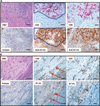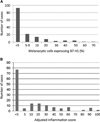Colocalization of inflammatory response with B7-h1 expression in human melanocytic lesions supports an adaptive resistance mechanism of immune escape
- PMID: 22461641
- PMCID: PMC3568523
- DOI: 10.1126/scitranslmed.3003689
Colocalization of inflammatory response with B7-h1 expression in human melanocytic lesions supports an adaptive resistance mechanism of immune escape
Abstract
Although many human cancers such as melanoma express tumor antigens recognized by T cells, host immune responses often fail to control tumor growth for as yet unexplained reasons. Here, we found a strong association between melanocyte expression of B7-H1 (PD-L1), an immune-inhibitory molecule, and the presence of tumor-infiltrating lymphocytes (TILs) in human melanocytic lesions: 98% of B7-H1(+) tumors were associated with TILs compared with only 28% of B7-H1(-) tumors. Indeed, B7-H1(+) melanocytes were almost always localized immediately adjacent to TILs. B7-H1/TIL colocalization was identified not only in melanomas but also in inflamed benign nevi, indicating that B7-H1 expression may represent a host response to tissue inflammation. Interferon-γ, a primary inducer of B7-H1 expression, was detected at the interface of B7-H1(+) tumors and TILs, whereas none was found in B7-H1(-) tumors. Therefore, TILs may actually trigger their own inhibition by secreting cytokines that drive tumor B7-H1 expression. Consistent with this hypothesis, overall survival of patients with B7-H1(+) metastatic melanoma was significantly prolonged compared with that of patients with B7-H1(-) metastatic melanoma. Therefore, induction of the B7-H1/PD-1 pathway may represent an adaptive immune resistance mechanism exerted by tumor cells in response to endogenous antitumor activity and may explain how melanomas escape immune destruction despite endogenous antitumor immune responses. These observations suggest that therapies that block this pathway may benefit patients with B7-H1(+) tumors.
Figures




References
-
- Benlalam H, Labarrière N, Linard B, Derré L, Diez E, Pandolfino MC, Bonneville M, Jotereau F. Comprehensive analysis of the frequency of recognition of melanoma-associated antigen (MAA) by CD8 melanoma infiltrating lymphocytes (TIL): Implications for immunotherapy. Eur. J. Immunol. 2001;31:2007–2015. - PubMed
-
- Kamposioras K, Pentheroudakis G, Pectasides D, Pavlidis N. Malignant melanoma of unknown primary site. To make the long story short. A systematic review of the literature. Crit. Rev. Oncol. Hematol. 2011;78:112–126. - PubMed
-
- Zou W, Chen L. Inhibitory B7-family molecules in the tumour microenvironment. Nat. Rev. Immunol. 2008;8:467–477. - PubMed
-
- Dong H, Strome SE, Salomao DR, Tamura H, Hirano F, Flies DB, Roche PC, Lu J, Zhu G, Tamada K, Lennon VA, Celis E, Chen L. Tumor-associated B7-H1 promotes T-cell apoptosis: A potential mechanism of immune evasion. Nat. Med. 2002;8:793–800. - PubMed
Publication types
MeSH terms
Substances
Grants and funding
- CA97085/CA/NCI NIH HHS/United States
- R01 DK080736/DK/NIDDK NIH HHS/United States
- R01DK080736/DK/NIDDK NIH HHS/United States
- CA85721/CA/NCI NIH HHS/United States
- R01DK081417/DK/NIDDK NIH HHS/United States
- R01 DK081417/DK/NIDDK NIH HHS/United States
- CA016359/CA/NCI NIH HHS/United States
- R01 CA142779/CA/NCI NIH HHS/United States
- R01 CA163594/CA/NCI NIH HHS/United States
- R01 CA085721/CA/NCI NIH HHS/United States
- P30 CA006973/CA/NCI NIH HHS/United States
- R01 CA097085/CA/NCI NIH HHS/United States
- P30 CA016359/CA/NCI NIH HHS/United States
LinkOut - more resources
Full Text Sources
Other Literature Sources
Medical
Research Materials

